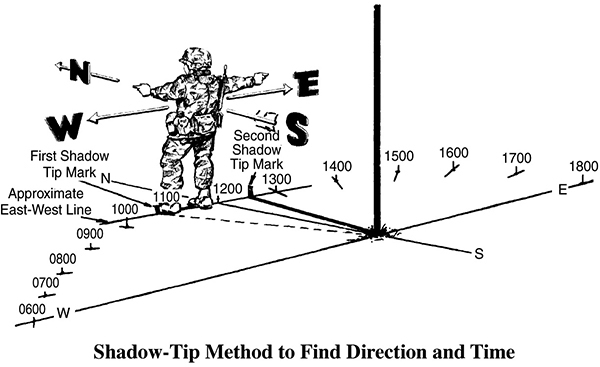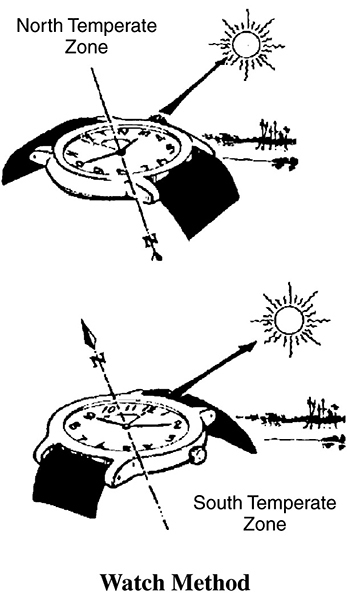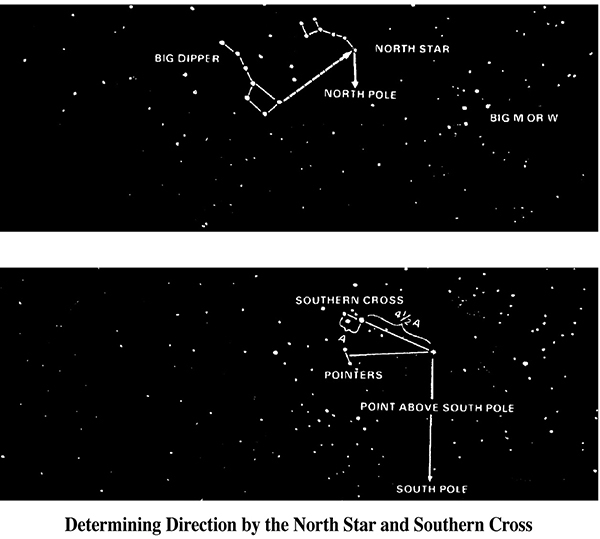Orienting Compass and Map
Place the compass on the map so that the cover of the compass is pointing toward the top of the map. Align the sighting wire or the straight edge of the compass over a north-south grid line, and rotate the map and compass together until the north arrow of the compass points in the same direction and number of degrees as shown in the current, updated grid-magnetic angle.
FIELD EXPEDIENT METHODS—USING THE SUN AND STARS
When a compass is not available, different techniques should be used to determine the four cardinal directions.
Shadow-Tip Method
This simple and accurate method of finding direction by the sun consists of four basic steps:
Step 1. Place a stick or branch into the ground at a level spot where a distinctive shadow will be cast. Mark the shadow tip with a stone, twig, or other means. This first shadow mark is always the west direction.
Step 2. Wait ten to fifteen minutes until the shadow tip moves a few inches. Mark the new position of the shadow tip in the same way as the first.
Step 3. Draw a straight line through the two marks to obtain an approximate east-west line.
Step 4. Standing with the first mark (west) to your left, the other directions are simple: north is to the front, east is to the right, and south is behind you.
A line drawn perpendicular to the east-west line at any point is the approximate north-south line. If you are uncertain which direction is east and which is west, observe this simple rule—the first shadow-tip mark is always in the west direction, everywhere on earth.
The shadow-tip method can also be used as a shadow clock to find the approximate time of day (see the figure). Move the stick to the intersection of the east-west line and the north-south line, and set it vertically in the ground. The west part of the east-west line indicates 0600 hours and the east part is 1800 hours, anywhere on earth, because the basic rule always applies.

The north-south line now becomes the noon line. The shadow of the stick is an hour hand in the shadow clock, and with it you can estimate the time using the noon and 6 o’clock lines as your guides. Depending on your location and the season, the shadow may move either clockwise or counterclockwise, but this does not alter your manner of reading the shadow clock.
The shadow clock is not a timepiece in the ordinary sense. It makes every day twelve unequal hours long, and always reads 0600 hours at sunrise and 1800 hours at sunset. The shadow clock time is closest to conventional clock time at midday, but the spacing of the other hours compared with conventional time varies somewhat with the locality and the date. However, it does provide a satisfactory means of telling time in the absence of properly set watches.
The shadow-tip system is not intended for use in polar regions, which the Department of Defense defines as being above 60 degrees latitude in either hemisphere.
Watch Method
A watch can be used to determine approximate true north and true south. In the north temperate zone only, the hour hand is pointed toward the sun. A south line can be found midway between the hour hand and 1200 hours, standard time. If daylight saving time is in effect, the north-south line is found between the hour hand and 1300 hours. If there is any doubt as to which end of the line is north, remember that the sun is in the east before noon and in the west after noon.
A watch may also be used to determine direction in the south temperate zone, but the method is different. The 1200-hour dial is pointed toward the sun, and the north line is halfway between 1200 hours and the hour hand. If on daylight saving time, the north line lies midway between the hour hand and 1300 hours.
The watch method can be in error, especially in the lower latitudes, and may cause circling. To avoid this, make a shadow clock and set your watch to the time indicated. After traveling for an hour, take another shadow-clock reading. Reset your watch if necessary.

Star Method
Fewer than sixty of approximately five thousand stars visible to the eye are used by navigators. The stars we see when we look up at the night sky are not evenly scattered across the whole sky; they are grouped in constellations. Which constellations we see depends on where we are, the time of the year, and the time of the night. The night sky changes with the seasons because the earth revolves around the sun, and it also changes from hour to hour because the rotation of the earth makes some constellations seem to travel in a circle. But the North Star, also known as the Polar Star or Polaris, is in almost exactly the same place in the sky every night, all night long.
The North Star is less than 1 degree off true north and does not move because the axis of the earth is pointed toward it. It is the last star in the handle of the Little Dipper. Two stars in the Big Dipper are a help in finding the North Star; they are called the Pointers, and an imaginary line drawn through them five times their distance points to the North Star. There are many stars brighter than the North Star, but none is more important. However, the North Star can be seen only in the Northern Hemisphere, so it cannot serve as a guide south of the equator. The farther north you go, the higher the North Star is in the sky; above latitude 70 degrees, it is too high in the sky to be useful.
When navigating using the stars as guides, you must know the different constellation shapes and their locations throughout the world. Depending on the star selected for navigation, azimuth checks may be necessary. A star near the north horizon serves for about a half hour. When moving south, azimuth checks should be made every fifteen minutes. When traveling east or west, the difficulty of staying on azimuth is more likely caused by the star climbing too high in the sky or disappearing below the horizon than by the star changing direction angle. When this happens, it is necessary to choose another guide star.

The Southern Cross is the main constellation used as a guide south of the equator, and the general directions above for using north and south stars are reversed.
MAP READING
Being in the right place at the right time is essential on the battlefield, so map-reading and land-navigation skills are important for every soldier.
Military Grid System
A military grid system is a network of squares formed by north-south and east-west grid lines placed on a map. The distance between grid lines represents 1,000 or 10,000 meters, depending on the scale of the map. A grid system enables the map reader to locate a point on a map quickly and accurately.
A grid line is identified by a specific number printed in the margin directly opposite the line it indicates. Any point on a map can be identified by coordinates. Following are rules for reading grid coordinates:
1.Large, bold-faced numbers in the margin label each grid line.
2.Starting at the lower left-hand corner of the map, read right and up.
3.Write the coordinates as a continuous series of numbers. The first half of the total number of the digits represents the “right” reading; the last half represents the “up” reading.
Following are examples using a map with 1,000-meter grid squares:
•Location of a point within a 1,000-meter grid square. Use this method to designate an object that is easily identifiable within a large area. Identify the grid square by using the numbers of the two grid lines intersecting at the lower left-hand corner, e.g., 9176.